Q.1. A satellite of mass m is launched vertically upwards with an initial speed u from the surface of the earth. After it reaches height R(R = radius of the earth), it ejects a rocket of mass m/10 so that subsequently the satellite moves in a circular orbit. The kinetic energy of the rocket is (G is the gravitational constant; M is the mass of the earth) (2020)
(1)
(2)
(3)
(4)
Ans. (2)
Solution.
According to law of conservation of energy, we have
Initial energy = Final energy
Ki + Ui = Kf + Uf
Where Ki is kinetic energy, Ui is initial potential energy, Kf is final kinetic energy and Uf is final potential energy. So,

 ................. (1)
................. (1)
Using conservation of momentum, we have
From Eq. (1), we get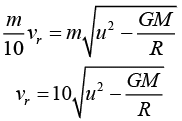
So, kinetic energy of rocket is given by



Q.2. A box weighs 196 N on a spring balance at the north pole. Its weight recorded on the same balance if it is shifted to the equator is close to (Take g = 10 m/s2 at the north pole and the radius of the earth = 6400 km) (2020)
(1) 195.66 N
(2) 194.32 N
(3) 194.66 N
(4) 195.32 N
Ans. (4)
Solution.
Given that, mg = 196 N ⇒ m = 19.6 kg
R = 6400 km = 6400 × 103 m
We know that, weight at equator is given by W= mg - mω2R
Q.3. Consider two solid spheres of radii R1 = 1 m, R2 = 2 m and masses M1 and M2, respectively. The gravitational field due to sphere (1) and (2) are shown. The value of M1/M2 is: (2020)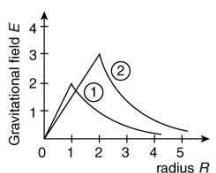 (1) 2/3
(1) 2/3
(2) 1/6
(3) 1/2
(4) 1/3
Ans. (2)
Solution.
Gravitational field on the surface of a solid sphere is given by
For Sphere 1, we have
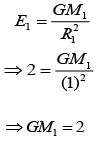 .............. (1)
.............. (1)
For sphere 2, we have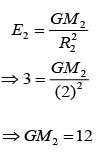 ................. (2)
................. (2)
From Eqs. (1) and (2), we have
Q.4. An asteroid is moving directly towards the centre of the earth. When at a distance of 10R (R is the radius of the earth) from the earths centre it has a speed of 12 km/s. Neglecting the effect of earths atmosphere, what will be the speed of the asteroid when it hits the surface of the earth (escape velocity from the earth is 11.2 km/s). Give your answer to the nearest integer in kilometer/s _______. (2020)
Ans. (16)
Solution.
Since, there is no loss of energy. Then, conservation of energy we have
Total energy of asteroid at distance 10R = Total energy of asteroid at distance R
Ki + Ui = Kf + Uf




Given that νe = 11.2 km/s, vi = 12 km/s
So, 

Q.5. A body A of mass m is moving in a circular orbit of radius R about a planet. Another body B of mass m/2 collides with A with a velocity which is half of the instantaneous velocity
of the instantaneous velocity of A. The collision is completely inelastic. Then, the combined body
of A. The collision is completely inelastic. Then, the combined body
(1) Continues to move in a circular orbit
(2) Escapes from the Planet’s Gravitational field
(3) Falls vertically downwards towards the planet
(4) Starts moving in the elliptical orbit around the planet (2020)
Ans. (4)
Solution.
Given that the body of mass m is moving in a circular orbit of radius R.
So, its orbital speed is given by
Where M is the mass of the planet.
Since, collision is inelastic. So, from conservation of linear momentum we have



Since after collision, the speed is not equal to orbital speed at that point. So, motion cannot be circular. Since velocity will remain tangential, so it cannot fall vertically towards the planet. Escape velocity of the object from planet is given by
So, νf < νe
Their speed after collision is less than escape speed, so they cannot escape gravitational field. So their motion will be elliptical around the planet.
Q.6. Planet A has mass M and radius R. Planet B has half the mass and half the radius of Planet A. If the escape velocities from the Planets A and B are vA and vB, respectively, then vA/vB = n/4. The value of n is (2020)
(1) 4
(2) 1
(3) 2
(4) 3
Ans. (1)
Solution.
Escape velocity from the planet is given by
Given that
So,


We have
Therefore, n/4 =1 ⇒ n = 4
Q 7. If the angular momentum of a planet of mass m, moving around the Sun in a circular orbit is L, about the center of the Sun, its areal velocity is (2019)
(1) L /m
(2) 4L/m
(3) L /2m
(4) 2L/m
Ans: (3)
Solution:
Consider a planet moving in an elliptical orbit from point A to B and traces small area dA at the focus in time dt. Let the angle traced by radius vector be  . The area of sector is given by
. The area of sector is given by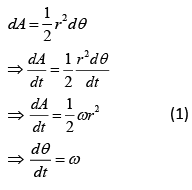
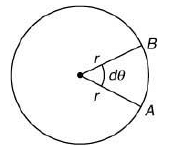
Now the instantaneous angular momentum is given by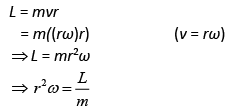
Substitute the value in Eq. (1), we have
Q 8. The energy required to take a satellite to a height h above Earth surface (radius of Earth = 6.4 × 103 km) is E1 and kinetic energy required for the satellite to be in a circular orbit at this height is E2. The value of h, for which E1 and E2 are equal, is (2019)
(1) 1.6 × 103 km
(2) 3.2 × 103 km
(3) 6.4 × 103 km
(4) 1.28 × 104 km
Ans: (2)
Solution:
The energy required to take satellite at height h above earth surface is equal to change in potential energy, that is, E1 = Uf – Ui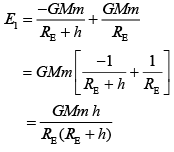
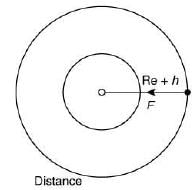
If satellite revolve around the earth at a distance (RE + h), the required centripetal acceleration will be provided by Gravitational attraction force. Thus,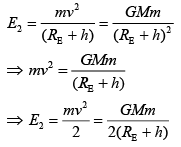
Therefore, E1 = E2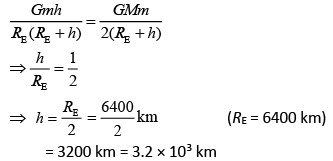
Q 9. A satellite is moving with a constant speed v in circular orbit around the earth. An object of mass m is ejected from the satellite such that it just escapes from the gravitational pull of the Earth. At the time of ejection, the kinetic energy of the object is (2019)
(1) 2mv2
(2) mv2
(3) 1/2 mv2
(4) 3/2 mv2
Ans: (2)
Solution:
By conservation of energy, we have
KE of Particle having mass (PE = KE = 0)
(PE = KE = 0)
KE of particle having mass

Therefore, KE of particle having mass m = mv2
Q 10. Two stars of masses 3 × 1031 kg each, and at distance 2 × 1011 m rotate in a plane about their common center of mass O. A meteorite passes through O moving perpendicular to the star’s rotation plane. In order to escape from the gravitational field of this double star, the minimum speed that meteorite should have at O is (take gravitational constant G = 6.67 × 10−11 N·m2·kg−2) (2019)
(1) 2.4 × 104 m/s
(2) 1.4 × 105 m/s
(3) 3.8 × 104 m/s
(4) 2.8 × 105 m/s
Ans: (4)
Solution:
Let v be the minimum speed of no meteorite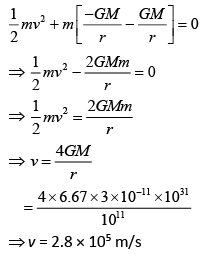
Q 11. A satellite is revolving in a circular orbit at a height h from the Earth surface, such that h ≪ R, where R is the radius of the Earth. Assuming that the effect of Earth’s atmosphere can be neglected, the minimum increase in the speed required so that the satellite could escape from the gravitational field of Earth is (2019)
(1) 
(2) 
(3) 
(4) 
Ans: (4)
Solution:
We have,
Centripetal force = Gravitational force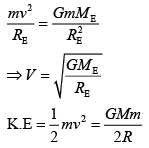
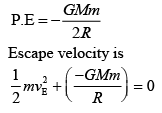

Now, change in velocity = vE – v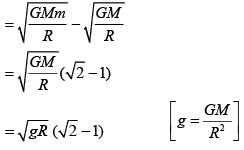
Q 12. A straight rod of length L extends from x = a to x = L + a. The gravitational force it exerts on a point mass m at x = 0, if the mass per unit length of the rod is A + Bx2, is given by (2019)
(1) 
(2) 
(3) 
(4) 
Ans: (4)
Solution: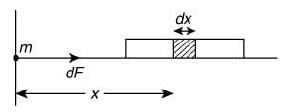
The mass per unit length of the rod,
dm = (A + Bx2)dx
Gravitational Force is
Integrating both the sides, we get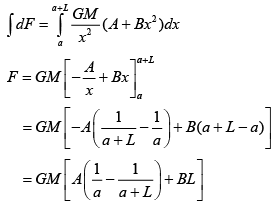
Q 13. A satellite of mass M is in a circular orbit of radius r about the center of the Earth. A meteorite of the same mass, falling toward the Earth collides with the satellite completely inelastically. The speeds of the satellite and the meteorite are the same, just before the collision. The subsequent motion of the combined body will be (2019)
(1) such that it escapes to infinity.
(2) in an elliptical orbit.
(3) in a circular orbit of a different radius.
(4) in the same circular orbit of radius R.
Ans: (2)
Solution:
Along x axis by conservation of momentum
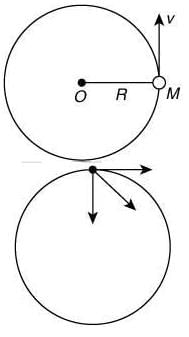
Along y axis by conservation of momentum
Total velocity
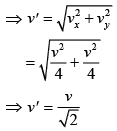
So, it is an elliptical orbit.
Q 14. Two satellites, A and B, have masses m and 2m, respectively. A is in a circular orbit of radius R, and B is in a circular orbit of radius 2R around the Earth. The ratio of their kinetic energies, TA/TB, is (2019)
(1) ½
(2) 1
(3) 2
(4) 
Ans: (2)
Solution:
Kinetic energy 
We know that orbital velocity is
Now, kinetic energy for satellite A
Therefore, ratio of KE is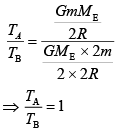
Q 15. A body of mass 'm' is moving in a circular orbit of radius R about a planet of mass 'M'. At some instant, it splits into two equal masses. The first mass moves in a circular orbit of radius R/2, and the other mass, in a circular orbit of radius 3R/2. The difference between the final and initial total energies is (2018)
(1) 
(2) 
(3) 
(4) 
Ans: (3)
Solution:
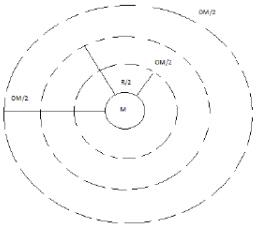





Q 16. Take the mean distance of the moon and the sun from the earth to be 0.4 x 106 km and 150 x 106 km respectively. Their masses are 8 x 1022 kg and 2 x 1030 kg respectively. The radius of the earth is 6400 km. Let ΔF1 be the difference in the forces exerted by the moon at the nearest and farthest points on the earth and ΔF2 be the difference in the force exerted by the sun at the nearest and farthest points on the earth. Then, the number closest to ΔF1/ΔF2 is: (2018)
(1) 10−2
(2) 2
(3) 6
(4) 0.6
Ans: B
Solution:



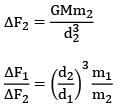

= (375)3 (4 × 10−8)
= (0.37 × 103)3(4 × 10−8)
= 1.64
Q 17. The relative uncertainty in the period of a satellite orbiting around the earth is 10–2. If the relative uncertainty in the radius of the orbit is negligible, the relative uncertainty in the mass of the earth is: (2018)
(1) 2 × 10–2
(2) 6 × 10–2
(3) 3 × 10–2
(4) 10–2
Ans: A
Solution:
From kepler's Law
Q 18. The variation of acceleration due to gravity g with distance d from centre of the earth is best represented by (R = Earth's radius): (2017)
(1) 
(2)
(3)
(4)
Ans: (2)
Solution: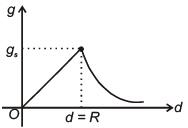
Variation of g inside earth surface


Q 19. If the earth has no rotational motion, the weight of a person on the equation is W. Determine the speed with which the earth would have to rotate about its axis so that the person at the equator will weigh 3/4 W. Radius of the earth is 6400 km and g = 10 m/s2. (2017)
(1) 0.63 × 10–3 rad/s
(2) 0.28 × 10–3 rad/s
(3) 1.1 × 10–3 rad/s
(4) 0.83 × 10–3 rad/s
Ans: (1)
Solution: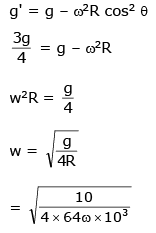

Q 20. The mass density of a spherical body is given by  and ρ(r) =0 for r > R, Where r is the distance from the centre. The correct graph that describes qualitatively the acceleration, a, of a test particle as a function of r is- (2017)
and ρ(r) =0 for r > R, Where r is the distance from the centre. The correct graph that describes qualitatively the acceleration, a, of a test particle as a function of r is- (2017)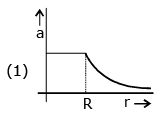
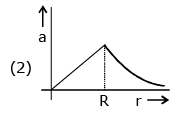
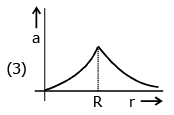
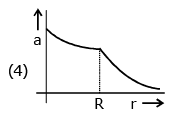
Ans: (1)
Solution:
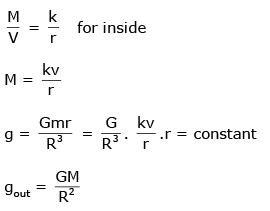
Q 21. A satellite is revolving in a circular orbit at a height ‘h’ from the earth’s surface (radius of earth R; h <<R). The minimum increase in its orbital velocity required, so that the satellite could escape from the earth’s gravitational field, is close to : (Neglect the effect of atmosphere). (2016)
(1) 
(2) 
(3) 
(4) 
Ans: D
Solution:
Orbital velocity v = 
Velocity required to escape
∴ Increase in velocity




















